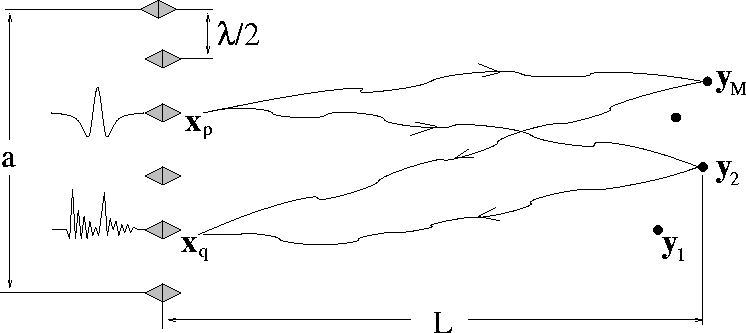Our analysis assumes that the
array has N transducers located at spatial positions
![]() , for
, for ![]() . (See Figure 1.)
When used in active mode, the array
probes the unknown acoustic medium containing M
small scatterers by emitting pulses and recording the time traces of
the back-scattered echos. We call the resulting data set the
multistatic array response (or transfer) matrix
. (See Figure 1.)
When used in active mode, the array
probes the unknown acoustic medium containing M
small scatterers by emitting pulses and recording the time traces of
the back-scattered echos. We call the resulting data set the
multistatic array response (or transfer) matrix
| |
(1) |
 |
For the numerical examples considered here, we will treat ultrasonic
imaging problems.
Our simulations assume that ![]() ,where
,where ![]() is the central wavelength,
is the central wavelength, ![]() is a characteristic length
scale of the inhomogeneity (like a correlation
length), a is the array aperture, and L
is the approximate distance to the targets from the array.
This is the regime where multipathing, or multiple scattering, is
significant even when the standard deviation of sound speed fluctuations
is only a few percent.
Values used in the codes are
is a characteristic length
scale of the inhomogeneity (like a correlation
length), a is the array aperture, and L
is the approximate distance to the targets from the array.
This is the regime where multipathing, or multiple scattering, is
significant even when the standard deviation of sound speed fluctuations
is only a few percent.
Values used in the codes are ![]() mm, a = 2.5mm,
and a background wave speed of c0 = 1.5km/s. More details
concerning the simulations may be found in Borcea et al. (2002).
mm, a = 2.5mm,
and a background wave speed of c0 = 1.5km/s. More details
concerning the simulations may be found in Borcea et al. (2002).
Typical array processing methods assume that the targets are far away from the array and, therefore, they look like points. Similarly, the propagation medium is assumed homogeneous and so the observed wavefronts scattered by the targets look like plane waves at the array. Array noise has usually been treated as due either to diffuse sources of white noise coming simultaneously from all directions, or to isolated ``noise'' having the same types of source characteristics as the targets of interest. But in random media with significant multiple scattering, the resulting ``noise'' cannot be successfully treated in these traditional ways.
Real-space time-reversal processing of the array response data involves an iterative procedure: sending a signal, recording and storing the scattered return signal, time-reversing and then rebroadcasting the stored signal, with subsequent repetitions. This procedure amounts to using the power method for finding the singular vector of the data matrix having the largest singular value. Alternatively, when the full response/transfer matrix has been measured for a multistatic active array, the resulting data matrix can be analyzed directly by Singular Value Decomposition (SVD) to determine not only the singular vector having the largest singular value, but all singular vectors and singular values -- simultaneously (Prada and Fink, 1994; Prada et al., 1996; Mordant et al., 1999).
Imaging is always done using a fictitious medium for the simulated backpropagation that produces these images since the real medium is not known. Its large-scale features could be estimated from other information, such as geological data obtained by seismic methods. For example, migration methods (Claerbout, 1976; Aki and Richards, 1980; Bleistein et al., 2001) can be used, where very large arrays -- much larger than those we contemplate using here -- are required. However, the small-scale random inhomogeneities are not known and cannot be effectively estimated, so the simplest thing to do is ignore them when imaging, and use methods that are statistically stable and therefore insensitive to the exact character of these small inhomogeneities.